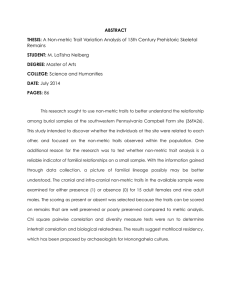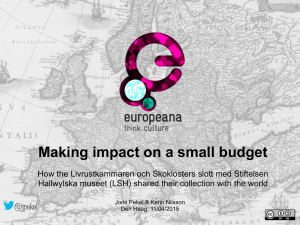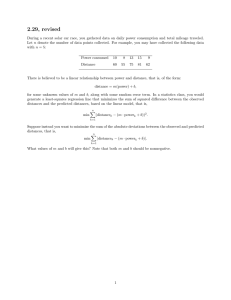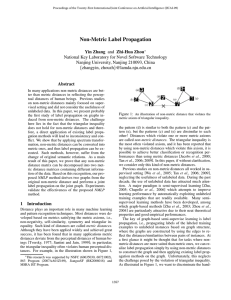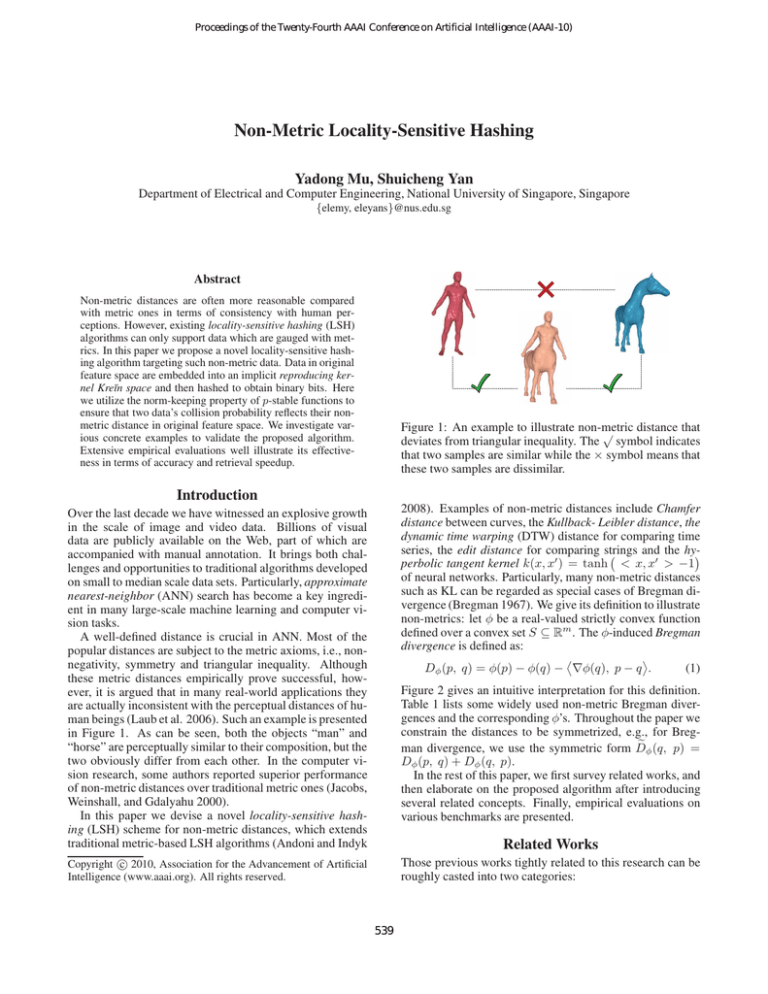
Proceedings of the Twenty-Fourth AAAI Conference on Artificial Intelligence (AAAI-10)
Non-Metric Locality-Sensitive Hashing
Yadong Mu, Shuicheng Yan
Department of Electrical and Computer Engineering, National University of Singapore, Singapore
{elemy, eleyans}@nus.edu.sg
Abstract
Non-metric distances are often more reasonable compared
with metric ones in terms of consistency with human perceptions. However, existing locality-sensitive hashing (LSH)
algorithms can only support data which are gauged with metrics. In this paper we propose a novel locality-sensitive hashing algorithm targeting such non-metric data. Data in original
feature space are embedded into an implicit reproducing kernel Kreı̆n space and then hashed to obtain binary bits. Here
we utilize the norm-keeping property of p-stable functions to
ensure that two data’s collision probability reflects their nonmetric distance in original feature space. We investigate various concrete examples to validate the proposed algorithm.
Extensive empirical evaluations well illustrate its effectiveness in terms of accuracy and retrieval speedup.
Figure 1: An example to illustrate non-metric
distance that
√
deviates from triangular inequality. The symbol indicates
that two samples are similar while the × symbol means that
these two samples are dissimilar.
Introduction
Over the last decade we have witnessed an explosive growth
in the scale of image and video data. Billions of visual
data are publicly available on the Web, part of which are
accompanied with manual annotation. It brings both challenges and opportunities to traditional algorithms developed
on small to median scale data sets. Particularly, approximate
nearest-neighbor (ANN) search has become a key ingredient in many large-scale machine learning and computer vision tasks.
A well-defined distance is crucial in ANN. Most of the
popular distances are subject to the metric axioms, i.e., nonnegativity, symmetry and triangular inequality. Although
these metric distances empirically prove successful, however, it is argued that in many real-world applications they
are actually inconsistent with the perceptual distances of human beings (Laub et al. 2006). Such an example is presented
in Figure 1. As can be seen, both the objects “man” and
“horse” are perceptually similar to their composition, but the
two obviously differ from each other. In the computer vision research, some authors reported superior performance
of non-metric distances over traditional metric ones (Jacobs,
Weinshall, and Gdalyahu 2000).
In this paper we devise a novel locality-sensitive hashing (LSH) scheme for non-metric distances, which extends
traditional metric-based LSH algorithms (Andoni and Indyk
2008). Examples of non-metric distances include Chamfer
distance between curves, the Kullback- Leibler distance, the
dynamic time warping (DTW) distance for comparing time
series, the edit distance for comparing strings and the hy-
perbolic tangent kernel k(x, x′ ) = tanh < x, x′ > −1
of neural networks. Particularly, many non-metric distances
such as KL can be regarded as special cases of Bregman divergence (Bregman 1967). We give its definition to illustrate
non-metrics: let φ be a real-valued strictly convex function
defined over a convex set S ⊆ Rm . The φ-induced Bregman
divergence is defined as:
Dφ (p, q) = φ(p) − φ(q) − ∇φ(q), p − q .
(1)
c 2010, Association for the Advancement of Artificial
Copyright Intelligence (www.aaai.org). All rights reserved.
Those previous works tightly related to this research can be
roughly casted into two categories:
Figure 2 gives an intuitive interpretation for this definition.
Table 1 lists some widely used non-metric Bregman divergences and the corresponding φ’s. Throughout the paper we
constrain the distances to be symmetrized, e.g., for Brege φ (q, p) =
man divergence, we use the symmetric form D
Dφ (p, q) + Dφ (q, p).
In the rest of this paper, we first survey related works, and
then elaborate on the proposed algorithm after introducing
several related concepts. Finally, empirical evaluations on
various benchmarks are presented.
Related Works
539
card coefficient (Broder et al. 1997), Hamming distance (Indyk and Motwani 1998), Arccos distance (Charikar 2002),
and ℓp distance with p ∈ [0, 2)(Datar et al. 2004). However,
none prior LSH work is devoted to the non-metric distances
such as Bregman divergence (although some of its special
cases are metrics, in general it is not).
Indefinite Kernels and Kreı̆n Space
Given a data set X = {xi }, i = 1 . . . n, we can construct
an n × n distance matrix D = (Dij ). As stated above, D
is assumed to be symmetric, and zero only for the diagonal
element. D is called squared-Euclidean if it is derived from
the ℓ2 metric. Let K = − 21 QDQ where Q = I − n1 eeT .
Q is the projection matrix onto the orthogonal complement
of e = (1, 1, . . . , 1)T . The transform results
in a central
ized kernel matrix K = (Kij ), with Kij = ψ(xi ), ψ(xj ) ,
where ψ is unknown mapping function. We have the following observation (Young and Householder 1938) (Laub and
Müller 2004):
Figure 2: Illustration for Bregman divergence (1-D case).
Table 1: Some convex functions and the corresponding
Bregman divergences.
′
φ(x)
φ (x, x )
P
P xD
xi
i
Itakura-Saito
− i log xi
′ − log x′ − 1)
i( x
i
i
P
P
Kullback-Leibler
xi log xi
xi log xxi′
i
Hinge
|x|
max(0, −2sign(x′ )x)
Theorem 1. D is squared-Euclidean if and only if K is positive semi-definite.
To plug K into kernel-based learning algorithms like support vector machine (SVM), one of the key requirements is
the positive definiteness. Unfortunately, kernel matrix K induced from non-metric distance matrix D occasionally violates this condition and falls into the family of indefinite
kernels (Pekalska and Haasdonk 2009). Figure 3 shows the
spectrum of such a matrix, where negative eigenvalues are
observed.
Tree based methods: researchers in computational geometry and database management communities developed
various tree-based structures for fast nearest neighbor retrieval, such as KD-tree (Bentley 1975) and VP-tree (Yianilos 1993). Most of these methods perform hierarchical space
decomposition, attaching similar data to adjacent leaf nodes.
These methods can be easily adapted to handle non-metric
data, including Bregman divergences. For example, the socalled Bregman ball tree (BB-tree) was proposed in (Cayton
2008), where each tree node is pertained to a Bregman ball
B(µ, R) = {x | Dφ (x, µ) ≤ R} (µ and R are center and
radius respectively). Given a query, the search for k-NN proceeds in a branch-and-bound way. A tree node is pruned if
the distance between query datum and its projection onto the
Bregman ball exceeds current upper bound. In (Zhang et al.
2009), similar tricks are developed to adapt for R-tree and
VA-file. The major disadvantages of these tree-based methods lie in the tremendous requirement of memory to store
tree node information (exponentially grows with respect to
data number and feature dimensionality) and limited performance enhancement when handling high-dimensional data.
LSH based methods: For many machine learning tasks, an
approximate nearest neighbor is almost as good as the exact
one in existence of noises. The concept of locality-sensitive
hashing (LSH) is supposed to well fit this appeal, especially
for high-dimensional data, c.f. (Andoni and Indyk 2008) for
a brief survey. Denote H as a family of hash functions mapping Rd to binary space. H is called “locality sensitive” if
under
h ∈ H, the collision probability
any hash function
PH h(p) = h(q) = Sim(p, q) (other formulations exist
but are in spirit the same), where Sim(·, ·) is a function measuring pairwise similarity.
Existing LSH families rely on well-defined metrics or
similarity functions in the original feature space, e.g., Jac-
Figure 3: Typical spectrum of non-metric distance matrices.
Indefinite kernels fail to be embedded into the so-called
reproducing kernel Hilbert space (RKHS) (Scholkopf and
Smola 2001), but is fortunately interpreted by the notation of reproducing kernel Kreı̆n space (RKKS) (Bognar
1974)(Pekalska and Haasdonk 2009). Here “Kreı̆n space”
refers to a vector
space K equipped with an indefinite inner product ·, · K : K × K → R such that K admits
an orthogonal decomposition as a direct sum K = K+ ⊕
K− , where (K+ , κ+ (·, ·)) and (K− , κ− (·, ·)) are separable
Hilbert spaces with their corresponding positive definite inner products. The inner product of K, however, is the dif′
ference of κ+ and κ− , i.e., for any ξ+ , ξ+
∈ K+ and
′
ξ− , ξ− ∈ K− , we have
′
′
′
′
ξ+ + ξ− , ξ+
+ ξ−
= κ+ (ξ+ , ξ+
) − κ− (ξ− , ξ−
). (2)
K
Strong relationship between Kreı̆n space and indefinite
matrix K exists. Perform singular value decomposition
540
K = V T ΛV 1 and decompose the elements in the spectrum
Λ = Diag(λi ) into two parts, i.e., Λ+ = max(Λ, 0) and
Λ− = − min(Λ, 0). K can be transformed to be the difference of two positive semi-definite matrices:
K = K+ − K− = V T Λ+ V − V T Λ− V,
Proof. Denote the implicit Hilbert mapping function as
ψ. P The geometric mean can be computed as µψ =
m
1
). For a t-cardinality subset S ⊂ {1 . . . n},
i=1 ψ(x
m
√
Pi
1
let z = t i∈S ψ(xi ) and ze = t(z − µψ ). According to the central limit theorem, ze is distributed as Gaussian Φ(0, Σ), where Σ is the covariance matrix of X . Further applying a whitening transform, we can obtain the desired hash vector in K, i.e. r = Σ1/2 ze. For any datum x,
h(x) = ψ(x)T Σ1/2 ze.
Given Gram matrix G = ΨT Ψ, where each column of
Ψ corresponds to a feature vector in data set X . Similar
to (Schölkopf, Smola, and Müller 1998), it is easily veri− 21
(ΨQ)T ψ(x),
fied that zeT Σ1/2 ψ(x) = zeT (ΨQ)(QGQ)
√
1
1
T
where Q = I − m ee . Substituting ze = tΨ( 1t δS − m
e)T ,
where δS is a binary indicator vector for subset S. Finally
we get
i
h√ 1
1
1
p(x) =
t( δS − e)GQ(QGQ)− 2 QT ΨT ψ(x) (4)
t
m
i
h√
1
1
t( 1t δS − m
Let ω ,
e)GQ(QGQ)− 2 QT , thus the conclusion holds.
(3)
which implies that K can be embedded into a RKKS. Same
to the kernel tricks in RKHS, we need not know the explicit
mapping functions for K+ and K− .
The Proposed Hashing Algorithm
Step 1: ℓ2 -Keeping Projection in Hilbert Space
Based on the embedding into RKKS as in Equation 2, we
devise a two-step LSH scheme. The goal of step 1 is to pursue two
LSH families H
+ and H− such that ∀h+ ∈ H+ ,
PH+ h+ (p) = h+ (q) monotonically decreases with respect to the ℓ2 distance between p and q in K+ , i.e., ℓ2 LSH in K+ . The situation in K− is the same. Note that the
operations in K+ and K− are independent, thus in sequel
we ignore the subscripts +, − without confusion. Previous
work in (Datar et al. 2004) discovers that ℓp -norm keeping
hashing is feasible based on p-stable distribution, which is
defined as below:
Step 2: LSH in Kreı̆n Space
Definition 1. (p-stable Distribution): a distribution Π over
R is called p-stable, if ∃p ≥ 0 such that for any n real
numbers v1 . . . vn and i.i.d. variables X1 .P
. . Xn from Π,
P
p 1/p
v
X
shares
the
same
distribution
with
(
X,
i
i
i
i |vi | )
where X is a random variable from Π.
The relationship between the Kreı̆n Space K and the associated Hilber spaces K+ , K− can be summarized in Equation 2. For any ξ, ξ ′ ∈ K, denote the pairwise ℓ2 distance in
K as kξ − ξ ′ kK . Based on Equation 2 and the orthogonality
of K+ , K− , we have
Such stable distributions exist for any p ∈ (0, 2], e.g.,
kξ − ξ ′ k2K
• Cauchy distribution ΠC with density function c(x) =
1 1
π 1+x2 is 1-stable,
• Gaussian distribution ΠG with density function g(x) =
2
√1 exp − x
2 is 2-stable.
2π
′ 2
′ 2
= kξ+ − ξ+
kK+ − kξ− − ξ−
k K−
=
′
′
kK+ − kξ− − ξ−
k K− ×
kξ+ − ξ+
′
′
kξ+ − ξ+
kK+ + kξ− − ξ−
k K−
(5)
Denote D− (ξ, ξ ′ ) , (|p+ (ξ)−p+ (ξ ′ )|−|p− (ξ)−p− (ξ ′ )|)
and D+ (ξ, ξ ′ ) , (|p+ (ξ)−p+ (ξ ′ )|+|p− (ξ)−p− (ξ ′ )|). It is
easy to verify that the means of D− and D+ are proportional
to the magnitudes of the two factors in Equation 5. We can
thus make the following approximation:
kξ − ξ ′ k2K ∝ |p+ (ξ) − p+ (ξ ′ )| − |p− (ξ) − p− (ξ ′ )| ×
|p+ (ξ) − p+ (ξ ′ )| + |p− (ξ) − p− (ξ ′ )| (6)
Here we are interested in the case of p = 2 and thus capitalize on the above Gaussian distribution. Suppose the data
lie in Rd . Existing hashing family H : Rd → R, each h ∈ H
has the form h(x) = rT x for any x ∈ Rd . Here each entry
of the hashing vector r ∈ Rd is randomly sampled from ΠG .
It is provable that H is norm-keeping, i.e. for v1 and v2 , the
difference |rT v1 − rT v2 | = |rT (v1 − v2 )| is distributed as
kv1 − v2 k2 X where X is a random variable from ΠG .
Unfortunately, since all we have is the kernel matrices
K+ , K− , such a linear representation is infeasible. Here
we resort to a trick similar to the ones previously used in the
kernel PCA (Schölkopf, Smola, and Müller 1998) and kernel LSH (Kulis and Grauman 2009). Our main observation
is as below:
Based on the project functions p+ , p− obtained in step 1,
we introduce two auxiliary functions a1 , a2 , whose definitions are as below:
a1 (ξ) = p+ (ξ) − p− (ξ)
a2 (ξ) = p+ (ξ) + p− (ξ)
Theorem 2. (ℓ2 -Keeping Projection in RKHS) Denote
κ(·, ·) to be the inner product in Hilbert space K. Given
an m-cardinality data set X and corresponding Gram matrix G, the
ℓ2 -metric keeping projection can be expressed as
Pm
p(x) = i=1 ω(i)κ(x, xi ), where ω(i) only relies on G.
(7)
(8)
Without loss of accuracy, both a1 (ξ) and a2 (ξ) are normalized to [0, 1]. Denote as ã1 (ξ) and ã2 (ξ) respectively.
The adopted hash function h : R2 → {0, 1}2 casts 2-D vector (a1 (·) a2 (·))T into two binary bits (h1 (·) h2 (·))T . The
scheme is as below (here k denotes 1 or 2):
1, ãk (ξ) > θ
hk (ξ) =
(9)
0, ãk (ξ) ≤ θ
1
In this paper we use K or G for the Gram matrices and K for
Hilbert spaces.
541
where θ is a real number randomly sampled from [0, 1]. In
this way, for any ξ, ξ ′ ∈ K, the Hamming distance between
their hashing bits shall be one number of {0, 1, 2}. It is interesting to investigate how the Hamming distance is related
to the distance in original feature space, i.e., kξ − ξ ′ k2K . In
fact, we have the following observation:
Theorem 3. (Collision Probability) For any ξ, ξ ′ ∈ K, denote |ã1 (ξ) − ã1 (ξ ′ )| = p1 and |ã2 (ξ) − ã2 (ξ ′ )| = p2 .
Let Dham be the Hamming distance between h(ξ) and
h(ξ ′ ). Under the hash scheme in Equation 9, Dham attains values 0, 1, 2 with probabilities (1 − p1 )(1 − p2 ),
p1 (1 − p2 ) + (1 − p1 )p2 , and p1 p2 respectively.
′
Table 2: Data sets description and the corresponding non-metric
distances (or similarities).
DATA S ET
I NTERNETA DS
L OCAL -PATCH
CIFAR-10
USPS-D IGIT
D+ (ξ, ξ ′ )
Dataset Description
In this section we provide quantitative study for the proposed non-metric LSH algorithm. We adopt four benchmarks, whose information and the corresponding applied
non-metric distances are listed as below:
InternetAds represents a set of possible advertisements on
Internet pages. Most features are binary, conveying webpage’s information including the image’s URL and alt text,
the anchor text, and words occurring near the anchor text.
On this data set, we adopt the Tversky linear contrast similarity (Tversky 1977) to measure the pairwise similarity.
CIFAR-10 is a labeled subset of the well-know 80 million “tiny image” data set constructed at MIT, consisting
of 60K 32 × 32 highly-smoothed images in 10 categories.
The dataset is constructed to learn meaningful recognitionrelated image filters whose responses resemble the behavior
of human visual cortex. For each image, we extract 387-d
GIST feature, and apply the Itakura-Saito divergence.
Local-Patch is a large-scale data set used to compare image
matching algorithms in computer vision. It contains roughly
300K 32 × 32 image patches from photos of Trevi Fountain
(Rome), Notre Dame (Paris) and Half Dome (Yosemite).
For each image patch, we compute a 128-d SIFT vector
as the holistic descriptor. These SIFT vectors are then ℓ1 normalized and measured by KL-distance.
USPS-digit contains grayscale handwritten digit images
scanned from envelopes by the U.S. Postal Service. It includes roughly 10K samples for digits 0 ∼ 9. For each image, we first convert it into binary image via thresholding,
and then adopt Chamfer distance (Barrow et al. 1977) as
distance measure.
Table 2 summaries the information of these benchmarks,
and in Figure 4, we present several images sampled from the
above-mentioned data sets.
′
= |(p+ (ξ) − p− (ξ)) − (p+ (ξ ′ ) − p+ (ξ ′ ))|
= |ã1 (ξ) − ã1 (ξ ′ )|
(10)
′
= |ã2 (ξ) − ã2 (ξ )|
(11)
Case 2: (p+ (ξ) − p+ (ξ ′ )) × (p− (ξ) − p− (ξ ′ )) < 0:
D− (ξ, ξ ′ ) =
D+ (ξ, ξ ′ ) =
|ã2 (ξ) − ã2 (ξ ′ )|
|ã1 (ξ) − ã1 (ξ ′ )|
D ISTANCE /S IMILARITY
T VERSKY
I TAKURA -S AITO
KL
C HAMFER
Experiments
Proof. The two terms D+ (ξ, ξ ), D− (ξ, ξ ) in Equation 6
can be determined as below:
Case 1: (p+ (ξ) − p+ (ξ ′ )) × (p− (ξ) − p− (ξ ′ )) ≥ 0:
D− (ξ, ξ ′ )
S AMPLE N UMBER
2359
300K
60K
10K
(12)
(13)
In either case, Dham can be determined by p1 and p2 , thus
the conclusion can be easily verified.
The Retrieval Algorithm
After the construction of hash tables, another challenge is
to encode out-of-sample data and retrieve its approximate
nearest neighbors. Given a query x, we calculate its nonmetric distance to all elements in X to get DΨ,ψ(x) . Let
Vdiag (K) ∈ Rn be the vector formed by the diagonal elements of K. Recall that K ∈ Rn×n contains the inner
products of centralized data,
it can be verified that κ(x, x) =
1
e
D
−V
(K)
, and further obtain the inner proddiag
Ψ,ψ(x)
n
uct between X and x:
1
ΨT ψ(x) = − Q DΨ,ψ(x) − Vdiag (K)
(14)
2
T
e be the
Recall that K can be decomposed as V ΛV , let K
new kernel matrix with x plugged in. As an approximation,
e can be expressed in the following form:
we assume K
e = KT ≈ VT Λ+ V T − VT Λ− V T ,
K
(15)
u
u
u
where the vector u ∈ Rn is the parameter to estimate. The
optimal u∗ can be pursued by solving the following leastsquared problem:
2
u∗ = arg min V Λ+ u − V Λ− u − ΨT ψ(x)
u
2
2
T
= arg min V Λu − Ψ ψ(x) 2
(16)
u
whose closed-form solution is available, i.e., u∗ =
((V Λ)T (V Λ))−1 (V Λ)T ΨT ψ(x). After that, the inner
products in K+ , K− can be simply determined according
to κ+ (xk , x) = vk Λ+ u∗ and κ− (xk , x) = vk Λ− u∗ respectively, where vk is the k-th row of V .
Figure 4: Example images from benchmarks used in this paper.
Evaluation Methodology
In our evaluation, each data set is divided into two part: one
is used to construct the hash functions (the sample numbers
542
• First perform hashing based on K+ or K− independently,
and then simply concatenate them (in other words, the
hamming distance between two data are the summation
of their distances calculated from K+ and K− ).
vary among different data set, depending on the whole data
size and intrinsic complexity lying in the data), and the rest
is kept for evaluation. Once hash functions are obtained
from the former subset, all elements in the evaluation subset are projected to the hash buckets accordingly. To gauge
the performance, we adopt the leave-one-out cross validation (LOOCV) method. In practice, we randomly sample
500 ∼ 1000 data as queries and the final performance is
averaged over all samples.
Specifically, the performance of a hash algorithm is estimated according to the Good Neighbor Ratio (GNR) criterion. Here “good neighbor” indicates the samples which are
adjacent to the query. Given the non-metric distance definition, it is possible to calculate any sample’s proximity rank
relative to a query. Typically the top 5% nearest samples to
the query are regarded as “good neighbor”. To evaluate, we
can simply count the proportion of good neighbors in the retrieved data set below a pre-defined Hamming distance (e.g.,
1 or 2).
Note that Kernelized LSH based on K is infeasible due
to K’s indefinite property. Our aim is to check whether the
two Hilbert spaces pertained to K+ and K− contain complementary information to each other. In Figure 7, it is observed that in most cases the GNR values of the proposed
LSH algorithm is consistently superior to the results based
on either K+ or K− , or their direct concatenation, which
serves as a strong sign that K− carries useful information for
data transform. Traditional learning algorithms from indefinite kernels tend to ignore negative singular values as noises.
However, here we argue that such a treatment possibly bring
information loss, and the proposed method provides a simple solution to overcome this issue.
Experimental Results
To illustrate the indefinite property of non-metric distances
(or equivalently similarities), we calculate the Gram matrices between 500 random samples for all four benchmarks,
and then perform spectral analysis, as seen in Figure 5. The
positive singular values are plotted in red, while the negative
ones are colored in blue. It can be seen that in most cases
the spectral energy from K− cannot be ignored.
Figure 6: Parameter stability testing results. See text for description. For better viewing, please see original color pdf file.
We also study the influence of parameters m and t (see
Theorem 2) used in hash function construction. We conduct
two additional experiments on the InternetAD data set. In
the first experiment, we vary m and fix t = 14 m. Figure 6
plots the performance evolutionary curve. While in the second experiment, we fix m = 50 an let t vary from 10 to 40,
as shown in Figure 6. In both cases, the proposed method
shows relatively stable performance.
Figure 5: Spectrums corresponding to four different non-metric
distances or similarities. For better viewing, please see original
color pdf file.
Figure 7 presents the experimental results based on the
GNR criterion. On each data set, we run 10 independent
rounds to reduce randomness. The hashing methods involved in the figures are as below:
Conclusions
Traditional LSH methods focus on well-known metrics such
as Euclidean distance and Cosine similarity. In this paper
we investigate the practicability of hashing methods given
non-metric distance measure. We show that symmetric
non-metric distances can be elegantly interpreted by Kreı̆n
space theory, and derive a two-step locality-sensitive hash-
• Our proposed non-metric LSH algorithm
• Kernelized LSH (Kulis and Grauman 2009) based on K+
• Kernelized LSH based on K−
543
Figure 7: Experimental results. The left and middle columns presents GNR values of the four benchmarks, and the right column shows the
decreasing tendency of retrieved samples when the hash bits increase. For better viewing, please see original color pdf file.
ing method, which captures information contained in negative singular values, rather than simply abandoning them.
Acknowledgment: the work in this paper is supported
by NRF/IDM Program at Singapore, under research Grant
NRF2008IDMIDM004-029.
Indyk, P., and Motwani, R. 1998. Approximate nearest neighbors:
towards removing the curse of dimensionality. In STOC.
Jacobs, D.; Weinshall, D.; and Gdalyahu, Y. 2000. Classification
with nonmetric distances: Image retrieval and class representation.
IEEE Trans. Pattern Anal. Mach. Intell. 22(6):583–600.
Kulis, B., and Grauman, K. 2009. Kernelized locality-sensitive
hashing for scalable image search. In ICCV.
Laub, J., and Müller, K.-R. 2004. Feature discovery in non-metric
pairwise data. Journal of Machine Learning Research 5:801–818.
Laub, J.; Macke, J.; Müller, K.-R.; and Wichmann, F. A. 2006. Inducing metric violations in human similarity judgements. In NIPS,
777–784.
Pekalska, E., and Haasdonk, B. 2009. Kernel discriminant analysis
for positive definite and indefinite kernels. Pattern Analysis and
Machine Intelligence, IEEE Transactions on 31(6):1017–1032.
Scholkopf, B., and Smola, A. J. 2001. Learning with Kernels: Support Vector Machines, Regularization, Optimization, and Beyond.
Cambridge, MA, USA: MIT Press.
Schölkopf, B.; Smola, A. J.; and Müller, K.-R. 1998. Nonlinear
component analysis as a kernel eigenvalue problem. Neural Computation 10(5):1299–1319.
Tversky, A. 1977. Features of similarity. Psychological Review
84:327–352.
Yianilos, P. N. 1993. Data structures and algorithms for nearest
neighbor search in general metric spaces. In SODA.
Young, G., and Householder, A. 1938. Discussion of a set of points
in terms of their mutual distances. Psychometrika 3(1):19–22.
Zhang, Z.; Ooi, B. C.; Parthasarathy, S.; and Tung, A. K. H. 2009.
Similarity search on bregman divergence: Towards non-metric indexing. PVLDB 2(1):13–24.
References
Andoni, A., and Indyk, P. 2008. Near-optimal hashing algorithms
for approximate nearest neighbor in high dimensions. Commun.
ACM 51(1):117–122.
Barrow, H. G.; Tenenbaum, J. M.; Bolles, R. C.; and Wolf, H. C.
1977. Parametric correspondence and chamfer matching: Two new
techniques for image matching. In IJCAI, 659–663.
Bentley, J. 1975. Multidimensional binary search trees used for
associative searching. Commun. ACM 18(9):509–517.
Bognar, J. 1974. Indefinite inner product spaces. Springer-Verlag.
Bregman, L. M. 1967. The relaxation method of finding the common point of convex sets and its application to the solution of problems in convex programming. USSR Computational Mathematics
and Mathematical Physics 7:200–217.
Broder, A. Z.; Glassman, S. C.; Manasse, M. S.; and Zweig, G.
1997. Syntactic clustering of the web. Computer Networks 29(813):1157–1166.
Cayton, L. 2008. Fast nearest neighbor retrieval for bregman divergences. In ICML, 112–119.
Charikar, M. 2002. Similarity estimation techniques from rounding
algorithms. In STOC, 380–388.
Datar, M.; Immorlica, N.; Indyk, P.; and Mirrokni, V. 2004.
Locality-sensitive hashing scheme based on p-stable distributions.
In Proceedings of the twentieth annual symposium on Computational geometry, 253–262.
544

